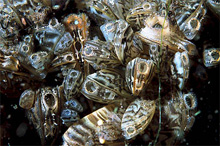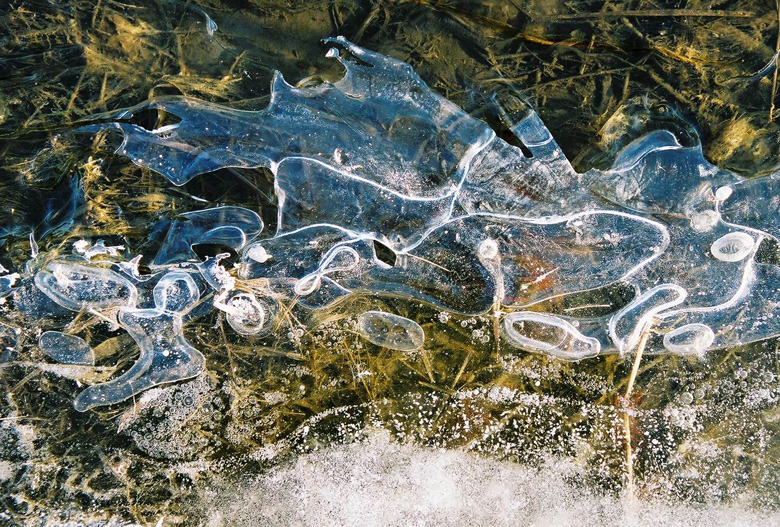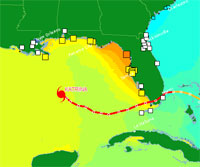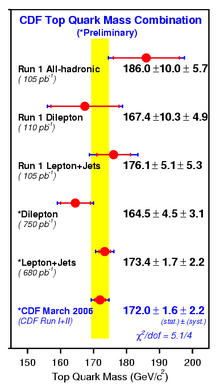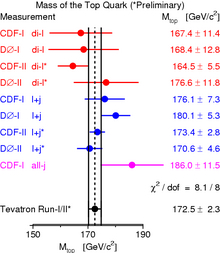 | Thursday, April 6, 2006 |
|
Thursday, April 6
Friday, April 7 |
|
Extended Forecast |
Secon Level 3 |
|
Thursday, April 6 -Minnesota Wild Rice w/Chicken -Tuna Melt on Nine Grain -BBQ Ribs -Chicken Casserole -Buffalo Chicken Wrap -Mexican Pizza -Mandarin Chicken Salad |
|
Thursday, April 6
Wednesday, April 12
Chez Leon Menu |
| Fermilab Today is online at: http://www.fnal.gov/today/ Send comments and suggestions to today@fnal.gov Fermilab Today archive Hurricane Relief Page Fermilab Today PDF Version Fermilab Result of the Week archive Fermilab Safety Tip of the Week archive Linear Collider News archive Fermilab Today classifieds Subscribe/Unsubscribe to |
|
Fermilab's zebra mussels:
Visiting without a pass
|
||
|
||
|
Fermilab's water-cooling pipes are teeming with zebra mussels. Dreissena polymorpha, a small freshwater mussel with zebra-striped shells, hitched a ride to the US on a ship from the Baltic about 20 years ago. When the ship dumped its ballast water into Lake St. Croix in Minnesota, the zebra mussels got dumped with it. With each adult producing as many as one million offspring per year, and no natural predators in the area, they soon got themselves onto the U.S. Fish and Wildlife Service's A-list of invasive species.
For about five years, the mussels have been taking over the more than 20 miles of pipeline under Fermilab, clogging the channels that connect the lab's ponds to the underground system that cools the equipment. "The numbers are beyond your imagination," said engineer Anne Lucietto of Facilities Engineering Services Section. Divers cleaning out the intake pipes in Casey's Pond found the one-to two-inch mussels coating the walls in a layer nearly a foot thick. As of today, they have removed nearly 8,000 pounds of mussel.
How the mussels arrived in the Fox River is a mystery. But "veligers"--zebra mussels in an early stage of development--can't be seen with the naked eye. They can catch rides on everything from scuba gear to the water on the back of a goose--another Fermilab visitor whose numbers seem beyond the imagination.
|
|
Predicting Extreme Weather With SCOOP
| ||
|
When a storm threatens the coastal United States, emergency-response managers look to scientists to help them prepare for potentially catastrophic consequences. Accurate predictions of the environmental response to extreme weather keep disaster recovery costs down and help save lives. Creating accurate and timely predictions requires bringing many different types of data from many different organizations together with a large amount of on-demand computing power—a task uniquely suited to cyberinfrastructure and grid computing. Read More |
|
|
LLNL Press Release, March 30, 2006: MINOS experiment sheds light on how neutrinos change 'flavors' LIVERMORE, Calif. — Scientists have successfully observed the transformation of neutrinos – a particle that is relatively massless, has no electric charge, yet is fundamental to the structure of the universe – from one type to another. The international team, including Livermore physicists Peter Barnes, Doug Wright and Ed Hartouni, working on the Main Injector Neutrino Oscillation Search (MINOS) project, today (March 30) announced the first results of a new neutrino experiment. |
| Over the top | ||
| ||
|
Measurements of the top quark mass at the Tevatron have reached levels of precision that have surpassed expectations, providing a stringent consistency check of the Standard Model.
The mass of the top quark is interesting because it is so large. The top quark is 35 times more massive than the next heaviest matter particle, the bottom quark, and twice as massive as the particles which carry the electroweak force. Because of this feature, a precise measurement of its mass helps determine that of the Higgs particle, and suggests it plays a special role in electroweak theory. Both CDF and DZero have established strong analysis teams to measure the mass of the top quark. CDF recently released five new results using 750 pb-1 of data collected at the Tevatron. These analyses use a variety of techniques to measure the top quark mass in distinct subsets of the data called "channels." The most precise results in each channel from both Run I and II are combined together for even further precision. While CDF and DZero had originally planned to measure the top mass uncertainty to ±3 GeV/c2, this combination yields a top mass measurement of 172.0 GeV/c2 with an uncertainty of only ±2.7 GeV/c2! Adding DZero's best Run I and Run II results yields a Tevatron combined result of Mtop = 172.5 ±2.3 GeV/c2, a precision of 1.3 percent. Forthcoming results from both experiments using their full 1 fb-1 data sets should allow a combined precision of 1 percent before the end of the year. There are hints of an interesting situation in these new results. This top mass tends to indicate a Higgs mass in a range where the Tevatron is most sensitive, and where the LHC would have the hardest time making a discovery. If this mass value persists as more data accumulates, it might indicate that the current theory is failing to explain the data, serving as our first hint of new physics beyond the Standard Model. |
||
| ||
| Result of the Week Archive
|
|
Come early to All-Hands meeting April 7 Secretary of Energy Samuel Wright Bodman will visit Fermilab on Friday morning, April 7. After a brief tour of the lab, he will hold an All-Hands meeting in Ramsey Auditorium at 11:00 a.m. Please plan to arrive by 10:45. Streaming video will be available, but Fermilab employees are encouraged to attend in person.
English Country Dancing
Science of Good and Evil
|
